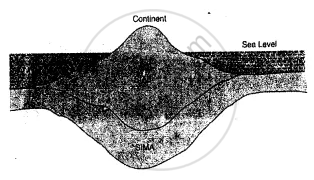Advertisements
Advertisements
प्रश्न
Explain the layers of the interior of the earth with reference to the following :
(a) Depth,
(b) Temperature
(c) Density.
उत्तर
Crust :
(a) Depth 35-50 km below continents and 6-12 km. below the oceans.
(b) Temperature — Less than 870°C
(c) Density — 2.7 g/Cm3 – 5.5 g/Cm3.
Mantle :
(a) Depth — 50 – 2900 km.
(b) Temperature — 1500° C – 2200°C
(c) Density — 3 g/Cm3 – 4.5 g/Cm3
Core :
(a) Depth — 2900 km – 3500 km
(b) Temperature — 2200°C – 5000°C
(c) Density — 10.0 g/Cm3 – 13.6 g/Cm3.
APPEARS IN
संबंधित प्रश्न
Where is asthenosphere found? In which form does it exist?
Temperature starts rising gradually towards the interior of the earth.
Describe the layers of the interior of the earth and their chemical composition.
There are two transitional zones between the two consecutive layers of the interior of the earth. Name them and state their chief characteristics.
Study the figure on the side and answer the question

What is known as Sial? How deep is the area marked by Sial?
“The whole of the approaching ship is not visible at one time.” Why?
Describe any three experiments to prove the Spherical Shape of the Earth.
Match the following:
| (a) | Crust | (i) | 2,171 km |
| (b) | Upper Mantle | (ii) | 2,259 km |
| (c) | Lower Mantle | (iii) | 30 km |
| (d) | Outer Core | (iv) | 1221km |
| (e) | Inner Core | (v) | 720 km |
Give reason for the following:
The Earth’s gravitational force
Consider the given statement
- When magnia reaches this Earth’s surface, it is referred to as ‘Lava’.
- The interior of the earth contains very hot molten material called ‘Magma’.
- Sedimentary are also called Primary (or) Mother rocks.
